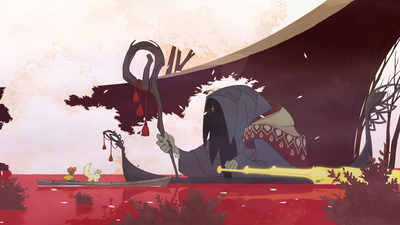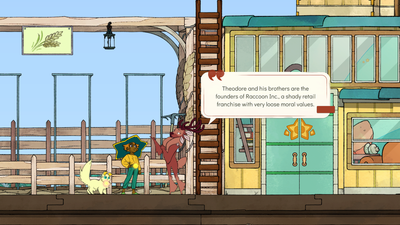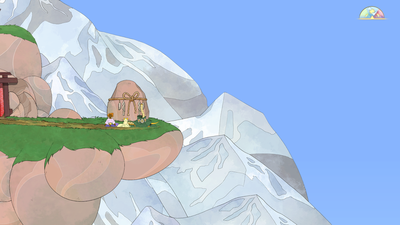Spiritfarer
The world of Spiritfarer is in between life and the afterlife, where the spirits of the dead run lemonade stands, go on meditation retreats, and look down on the less fortunate from skyscrapers while they prepare emotionally to pass on to the beyond. As the Spiritfarer, our protagonist Stella and her cat Daffodil are tasked with supporting reluctant spirits on their journey to the Everdoor. By building each spirit a unique home, cooking them their favorite meals, and giving them the best video game hugs I have ever seen, each spirit gradually comes to deal with their unique and challenging vestiges from the life before.

Substance aside, Spritfarer is absolutely beautiful. The hand-drawn assets and delightful animations make the game feel like a living storybook. For a game billed as “a cozy management game about dying,” the art is remarkably bright and lighthearted. It even has its own art book, which is an accomplishment for a small indie studio. The clip below has a bunch of my favorite animations, starting with a hug (I’m telling you, the hugs are bomb) and ending with the hidden gem of Daffodil’s yawn.
Spiritfarer balances its predilection for waxing philosophical on death with self-aware humor that is packed with internet in-jokes and a dash of anti-corporate sentiment. Midway through the game, Stella meets an NPC with the genre-typical responsibility of rewarding 100% completion: collect all that the game has to offer, and this spirit will give you rewards. But in a fun twist, this spirit hates her job and finds your catching, asphyxiating, cooking, and eating of “all the fish in the ocean” to be horrifying. (As an aside, Spiritfarer is yet another game that simultaneously promotes non-violence but imposes a hierarchy on nonhuman animal species that deems it non-problematic for anthropomorphic animals to kill and consume marine life including fish, squid, and octopi.)
As another example, we get an early nod to Tom Nook of Animal Crossing that lands not just for the many gamers who have spent most of their 2020 in New Horizons, but also for those of us who are growing increasingly concerned with the ethics of big corporations and poor treatment of workers.

The extent to which the developers succeed in promoting positive change is mixed. Within the first five-ish hours of gameplay, Spiritfarer establishes solid representation: Stella is a Black woman, two characters are LGBTQ, and several characters struggling with their mental health are portrayed compassionately. There’s the aforementioned focus on the plight of the worker, as we meet one character leading a protest against unjust labor practices and another who was a union leader in his past life. And, of course, there is the overarching goal of helping and caring for others as they seek peace.
The problem is that none of these key issues feel fully fleshed out; they’re simply presented and then brushed aside by Spiritfarer’s prevailing lightness. The labor dispute is resolved by the CEO’s comedic need to use the restroom overcoming his callous business sense. Mental health struggles are seemingly assuaged by Stella’s care and comfort. It is as if the core message of the game, intended or not, is that no injustice is too big to be solved by the benevolence and persistence of the oppressed: just cook someone their favorite foods and hug them often enough, and all their internalized trauma will simply disappear.
I’m all for meeting individual, tangible needs and loving our neighbors, but this must be done in concert with iterative, systems-level change. I won’t hold a video game to the unreasonably high standard of enacting real-world change, but if Spiritfarer is going to talk about real stuff, I will too.

Returning to gameplay, Spiritfarer has a very satisfying play loop where each task hooks into the next. It’s quite easy to loose track of time while playing: Travel somewhere new to find new spirits and materials. Use new materials to build, grow, and craft new things. Take those new things and cook and chop and weave and smelt and crush them into yet other things. Realize that you don’t have the things to meet your spirit passengers' food/improvement requests. Travel to a new place in search of those things. Repeat.
This satisfying loop lasts until roughly 75% through the game, at which point you and your ship become so capable of overproducing that many of the management tasks become irrelevant. I just had to remember to feed people during my obsession with secret-hunting, hopping between islands and doing very little to advance the story.
The platforming/metroidvania aspects of the game come in exploring the various islands, where new abilities allow you to reach literally greater heights in your search for materials, side quests, and upgrade blueprints. This never feels particularly overwhelming (like having to remember a specific location with a specific secret to come back to), though the quest log and the mail inventory could have been far better organized. (Also, Thunder Lotus, would it have been narrative breaking to let me check the ship’s map without having to go back to the Captain’s chamber? I know it’s powered by the Everlight, but Stella always has the Everlight on her…)

Spritfarer didn’t quite live up to the deeply thoughtful reflection on life and dying that I expected it to be, but it was a delightful game. I enjoyed the little moments — passing jokes, conversations with my spirit passengers, and those hugs — despite the fact that the narrative could have been a bit more explicit and punchy with its key points. As I write this, I realize I likely missed a small handful of those meandering, serendipitous moments that end up being the most memorable. In that sense, my take on Spiritfarer can be summed up by one of the first lines from Charon, Stella’s predecessor:
I cannot say that I am sad to leave, but I still had a few things left to do here.
Take care of each other.
Bugs
I only encountered two bugs during my playthrough, and both were minor.
- After rearranging the buildings on my ship, one of my passengers became stranded in the attic of the chicken coop, inaccessible to me and seemingly unaware of their predicament. This reset after quitting to the main menu.
- While running back and forth between the bellows in the Forge, Daffodil glitched. Her positioning reset after leaving the Forge.
Finally, a mini-rant on something that isn’t so much a technical bug as a design flaw: the secret achievements “Loose Lips” and “Sealed Lips” should absolutely not be in the game. Without spoilers, these achievements are unlocked based on engaging in a main quest conversation that — depending on how you play — can occur quite late in the game. Choose one dialogue option, you get “Loose Lips”; choose the other, you get “Sealed Lips.” Unless you know this ahead of time and do a janky hack of getting one achievement to pop, immediately quitting the game, and then redoing the conversation the other way, getting both achievements requires two playthroughs. These are the only achievements that cannot be obtained in a single run, and Spiritfarer is not a game with significant replay potential. This feels like a design flaw, where user experience clashes with the game’s systems.